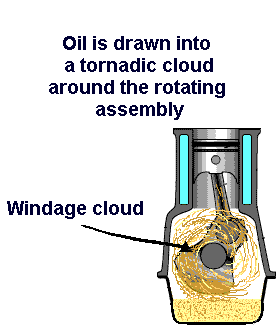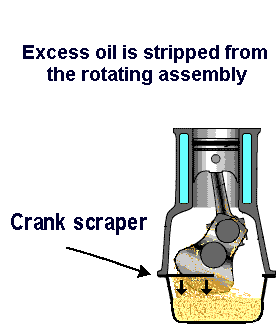Windage , what does it really mean and why do top builders agonize over it? Sure we all know about Fords factory windage tray and the back and forth online arguments by keyboard racers if they help, but lets get a little more in depth. For this I turned to one one of the few if not only company making crank scrapers for the FE Ishihara-Johnson in Port Richey Florida. So lets take a look at what windage is from their website
"During normal engine operation a significant amount of oil adheres to the rotating assembly or becomes entrained in a "windage" cloud surrounding it. It should be remembered that the particular characteristics of oil adhesion and/or oil-in-air entrainment vary depending on the engine rpm and what the vehicle is doing at the time. How the oil droplets are kept and drawn into the tornadic windage cloud is explained by the phenomenon known as the
Tea Leaf Paradox, which was first described by Albert Einstein in 1926. It is counterintuitive that oil droplets would be kept and drawn into ("entrained") rather than completely expelled out of the windage cloud due to centrifugal force.
When a portion of the total droplets are small enough in physical size the predominate influence on their behavior switches. Rather than just their momentum due to being ejected from or impacted by the rotating assembly they are guided by the air currents in the windage cloud.* This droplet behavior in a gas atmosphere, which is a type of "fluid", in the confined volume of the crankcase is what the Tea Leaf Paradox addresses. The oil droplets have a greater density than the gas molecules.
Remember that an "equilibrium" of entrained oil is reached for the particular operating conditions. This means that not all the oil is held but rather that the amount rises until a certain point is reached and then the extra is not taken in or it swaps places with oil already in the cloud that is then released. Generally the higher the rpm, the more oil that is held because of the higher pressure differential. It is not unusual for a quart or more of oil to be suspended in the cloud at high rpms in many engines.

"This impacted and entrained oil eats up horsepower your engine is making by increasing the rotating mass and also creating parasitic drag. At low rpms and in extreme conditions where the rotating assembly is flooded by sump oil, the crank scraper mechanically strips off excess oil by coming close to, but not touching, the moving crankshaft and rods. At high rpms it interferes with the pressure differential that draws oil into the windage cloud and allows a new lower equilibrium of entrained oil to be established."

Oil scrapers date back to the early days of aviation the V12 Merlin from WW2 had a basic crank scraper. Windage trays and scrapers both work independently or in tandem to keep the oil where it should be . Ford knew this early on with the factory windage trays and the little known crank scrapers in some factory oil pans .
So does a windage tray do the same as a scraper , no a windage tray serves a different but related basic function. It is present to act as a physical barrier between the rotating assembly and the sump reservoir. A crank scraper actively removes excess oil and returns it to the sump. Some windage trays do have scraper technology built into them but even then a dedicated scraper will approach the moving parts much more closely.
After reading up on the benefits of a scraper I decided to try one ,so I called the folks at Ishihara-Johnson to supply one. They were super helpful and had many patterns on file for our beloved FE , for various strokes and combinations . As this one was going into a 390 I ordered the basic 3.78 stroke, with some final fitment required. After a brief wait it arrived and I placed it on my engine to dial it in to my combo. I had to file a couple bolt holes to get proper alignment but nothing terrible, remember you don't want much room for movement due to the close fitment of the scraper. Following instructions I bolted it in place and rotated the crank till the first journal came in contact. Then I used a marker and began scribing the contact points , this process takes a while but was easier the more I got used to it. Once finished I rotated the engine over in the running direction a few times to ensure clearance, then fit my windage tray and oil pan and torqued them down. One more rotation showed some thing had moved and caused contact , after disassembly and a touch from my file the problem was solved. I will probably not get to do a before and after test but if history and research are accurate then this is will add a few HP or at the least keep the oil in the pan where it belongs. Is this right for your engine , that is your decision but I like the principle and effect so I will use one on any of my serious engines. So go online
crankscraper.com or call Ishihara-Johnson at (727) 808-8602 tell them you saw it here and remember its MADE IN THE USA!!!!!!












Comments
Post a Comment